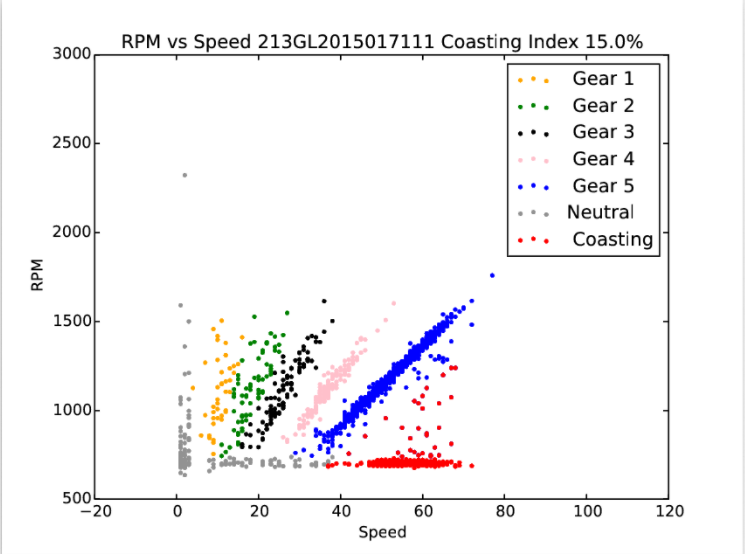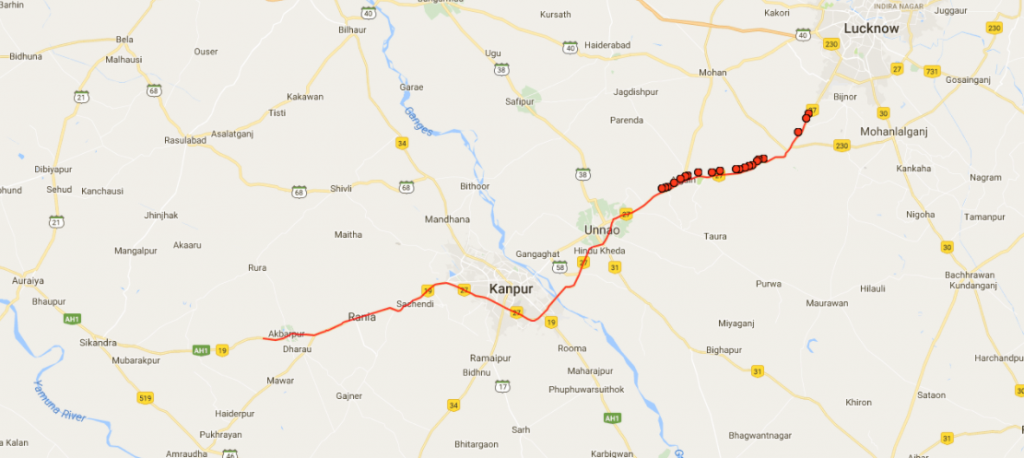Indian roads are among the most dangerous in the world. According the WHO reports, there are about 250,000 road fatalities annually in India. In comparison, 289 terrorism related deaths were reported in India in 2015. Road accidents are a serious problem and have several reasons. In this article we focus on a less known and less understood cause – Neutral Gear Driving. We will define what neutral driving is, why it happens, how policies of transportation companies inadvertently incentivise this dangerous behaviour. We will also present an IoT solution to monitor neutral driving and a metric to identify drivers who drive in neutral.
What is Neutral Gear Driving
In neutral drive, the clutch plate is completely disengaged from the pressure plate. It disengages all gears from the transmission, and disconnects transmission from the wheels. It is similar to have pressed the clutch fully in. In this mode the RPM of the vehicle settles down to it lowest values, typically between 700 – 800 depending on the type of vehicle. Since the RPM is least and there is practically no load on the engine, very little fuel is consumed in this mode. In case, the vehicle is being driven at a high speed, by switching to neutral the driver begins to coast, using mostly the momentum of vehicle or gravity to move. The fuel efficiency of the vehicle in this mode will be very high.
A driver drives in neutral to save fuel. It becomes exceptionally dangerous, when they do it going downslope. While going downslope in neutral gear, the vehicle consumes very little fuel as it moves mostly due to gravity. Since the clutch plate and pressure plate are completely disengaged there is no engine friction or engine control. You cannot control the vehicle with accelerator. We now have a vehicle weighing several tonnes, going down a slope at high speeds with very little control. The wheels are disconnected from the transmission and are moving only due to inertia and gravity. There is no engine brake or control. In case the driver sees a obstruction, he would have to react very quickly to brake, swerve or get the engine in gear. Often the driver loses control of the vehicle causing an accident. Neutral driving is the cause for several accidents that resulted in fatalities and financial damage.
Why does Neutral Driving Happen
Obviously, neutral driving is done to save fuel and reduce cost. Most transportation companies pay a fixed fuel expense to their drivers. So, a trip between Mumbai and Delhi, will have a pre-decided fuel rate e.g. 3 kms/litre. These rates are based on estimates built on experience. The Delhi-Mumbai trip is 1421 kms, so the transporter gives the driver 1421/3 * 60 = Rs. 28400 towards his fuel expenses. This amount is fixed, so if he consumes more, he would have to pay the difference from his pocket. If he consumes less, he pockets the difference. This works quite well in several ways for the transportation company. They don’t have to worry about monitoring fuel usage or fuel theft. They have reduced the variability of fuel expenses and have incentivised the driver to drive keeping fuel efficiency high.
This also means the driver is now incentivised to drive on neutral, especially on slopes, where he knows that gravity will do most of the work for him. Inadvertently, the transportation companies have incentivised the driver to take risks that could damage the vehicle, the customers consignment and possibly kill himself and other people on the road.
Can Neutral Driving be Detected
Neutral Driving can be detected by monitoring speed and RPM of the vehicle. As discussed earlier, if the speed of the vehicle is high and the RPM is at lowest values for the vehicle, then the vehicle is being driven in neutral gear. We have measured speed and RPM using OBD devices on cars, trucks and buses and detected neutral driving on these vehicles.

As seen in the figure above, with our algorithms we have been able to detect all gears and neutral driving (red spots). This driver drives on neutral about 15% of the time. We can also see that the driver begins to drive on neutral gear after he reached 60-65 kms/hr. He then goes back to gear at around 45 kms/hr. He does it opportunistically on highways and on slopes. We noticed similar behaviour in several professionally driven vehicles, including cars. It seems lots of professional drivers drive in neutral to save fuel.

We have observed incidences of neutral driving on national highways and on slopes. As seen in the picture above, this truck is rarely driven in neutral within city limits where there in dense traffic. On national highways we observed the drivers tend to accelerate to around 60-65 and then drop to neutral. The speed of vehicle slowly comes down and the driver puts in back to gear at around 45 kms / hr. We see much more dangerous behaviour on slopes. When the driver drives on neutral on slopes, the vehicles speed increases. High speeds, with less control.
Does Neutral Driving Save Fuel
We did some analyses of fuel consumption to check the impact of neutral driving on fuel consumption.
| Speed Range (km/hr) | Fuel Eff – Accelerating (km/lt) | Fuel Eff – Cruising (km/ltr) |
| 60 – 65 | 3.79 | 4.59 |
| 55 – 60 | 3.85 | 4.88 |
| 50 – 55 | 3.61 | 5.15 |
| 45 – 50 | 3.34 | 4.22 |
The table above shows the instantaneous fuel efficiencies at different speeds and depending on whether the vehicle was accelerating or cruising at constant. We see that the fuel efficiency of the vehicle peaks while cruising at around 55 kms/hr. The fuel efficiencies are dramatically lower while accelerating. So a driver who accelerates upto 60 kms/hr and then neutral drives down to 45 km/hr and then again accelerates to 60 kms/hr will have a lower fuel efficiency than a driver who drives at a fixed speed of 55 kms/hr. Unfortunately, most drivers just focus on the fuel savings while driving neutral and not on the fuel lost while accelerating to the preferred speed. All the fuel saved with neutral driving will be lost in acceleration, while the driver exposes himself and others on the road to a huge risk of fatal accidents.
Transporters and shippers can monitor the driving behaviour of the drivers to reduce probability of accidents, road fatalities and damages to their vehicles and consignment. It would make roads safer and reduce overall costs.
